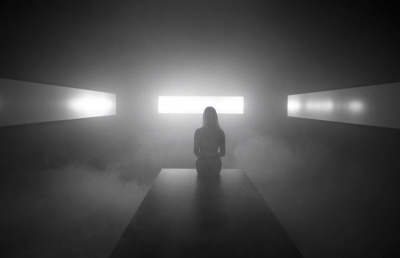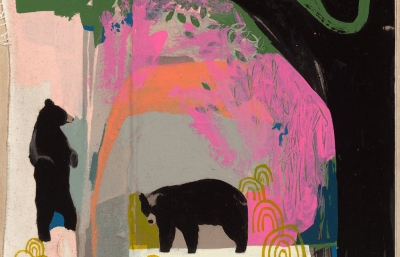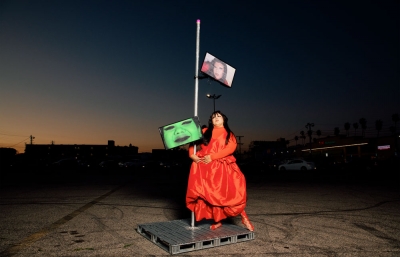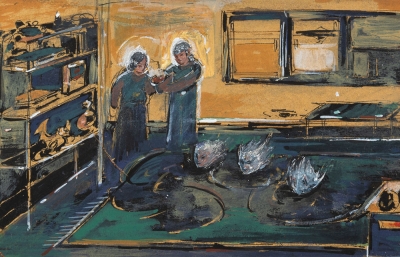For those who don’t consider Ohio a trendsetter, keep in mind that it’s known as both the Swing and Bellwether State. So while we’re seeking direction, we look beyond the Coasts and consider Kent State. It boasts courses in Italy, Switzerland and India, while bearing a very midwestern and eastern presence; a good place to gauge the current mood of college and learning. Naturally, we’re interested in art programs, so feel lucky to have the chance to share our conversation with a young teacher who is herself a working artist. As J. Leigh Garcia, a biracial Latina, looks out for her students and her commitment to portray undocumented immigration, she considers how to incorporate her own need to make art.
Gwynned Vitello: Are you in contact with your students right now, are you finishing up projects, or do things seem like they are in a holding pattern of sorts?
Leigh Garcia: We went on summer break at the end of April, so it’s been a few weeks now since I’ve had contact with my students—but we still have lots of loose ends to tie up. Because of the quick escalation of the pandemic, when we transitioned to remote instruction, we had very little time to prepare. Most students didn’t have time to pick up their art supplies from school. I graded projects that I didn’t get to return to students, and a lot of them had borrowed essential equipment like screening squeegees that still had to be returned. Even though the semester is over and grades submitted, there’s a lot of unfinished business. In a way, I think we all need some closure on the experience.
As a teacher and an artist, do you find that priorities have shifted, that you are giving attention to one more than the other, maybe compartmentalizing more than usual?
When we first transitioned to remote instruction and that state of Ohio issued a “stay-at-home” order, all of my energy went into teaching. I rewrote projects, navigated virtual communication, and made sure my students could access materials. It was a really stressful few weeks because I was not only figuring out logistics of how to teach online, but also because I felt a strong sense of moral and ethical responsibility. How much could I have expected of my students when so many had lost their jobs, were forced to move out of their dorms, and were struggling with their mental health, all at the same time. Not to mention they were dealing with the fear of themselves and their loved ones actually getting the virus. As a professor, I always push my students to reach their full potential, but during a pandemic, supporting them on a personal level feels more important. The question of how to balance course expectations and personal support weighed heavily on me, and still does. Because of that, it’s been hard to focus on my personal artwork.
Do you find time to make art right now, meaning are you more passionately motivated or is there too much anxiety to focus, or is it a weird combination of the two?
While a lot of exhibitions and events have been postponed, I still have deadlines that are keeping me busy. I recognize that working on my art is the best thing I can do for my mental health right now. Plus, it’s not like I have anywhere else to be during a “stay at home” order. aIt can feel very strange to make work about my biracial identity when there is so much stress happening globally. Yet the racial inequalities that the pandemic is emphasizing in our country motivate me to continue making this work. Even though I’m conceptually distracted by the pandemic, I’m taking this time to focus on sharpening some of my more technical printmaking skills. I’m also navigating how to make prints in my home studio as I no longer have access to my studio on campus.
Let’s step back a bit, as this will give more context. When I think of Dallas, where you grew up, I think of the old TV show, the Dallas Cowboys, tall buildings, sort of Big D in general. Is there such a thing as a Dallas, Texas influence? Your mom’s side of the family is 7th generation, and second generation Mexican on your dad’s, right?
Dallas is a big city with cultural diversity and friendly, outspoken people. Growing up there,and Texas in general, has been extremely influential in my artwork and personal identity. On my Mom’s side, we’ve been in North Texas for seven generations, so we feel a real sense of pride in the culture and land. However, as I’ve gotten older and moved out-of-state, I’ve recognized and reflected on how my white ancestors benefitted from colonization, slavery and racism, giving me the privilege me with an idealized perspective of Texas.
On my Dad’s side, I’m a second generation Mexican-American, or “Tejana.” My grandfather swam across the Rio Grande from Mexico to Texas to escape poverty. My biracial and bicultural heritage has always caused me to be fascinated with the history and racial relations of Texas. That’s what I make art about, and I’m very thankful to have been raised in a place I feel so passionately about … and that has the best Tex-Mex food on the planet!
When and how did you discover you wanted to make art?
Like most artists, ever since I can remember, I’ve had a knack for drawing and making things with my hands. However, it wasn’t until I applied and got into an arts magnet high school that I really started taking my work seriously. At my school, Booker T. Washington High School for the Performing and Visual Arts, half of my classes were dedicated to visual arts. It was amazing! When I took a printmaking class my junior year, I immediately fell in love and realized it was what I wanted to do the rest of my life.
What was the biggest impact that art school had on you? Any teachers, in particular, and what about collaborations with other students?
My high school printmaking teacher, Eva Kutdcheid, was extremely influential in how she shared her love and passion for printmaking. She also helped me acquire my first etching press after graduation. In undergrad, at the University of North Texas, my professors Andy DeCaen and Lari Gibbons were really knowledgeable. They helped me establish foundational printmaking techniques and an understanding of art within academia.
Then, in graduate school, at the University of Wisconsin-Madison, my professors John Hitchcock, Emily Arthur, Fred Stonehouse, Aris Georgiades and Faisal Abdu’allah, pushed me to conceptually develop a strong voice in my work. While in grad school, I collaborated with other students, professors, activists, water scientists and men facing deportation in a detention center. I’ve worked most collaboratively with my art partner Maria Amalia Wood making artwork about undocumented Latina immigrants. I love that, throughout art school, I've had the opportunity to work with and be influenced by so many incredible people. I think that’s what I love most about art, its ability to bring people together.
Tell me about your experience as an artist. Did you stay in Texas, have any special mentors, become part of a collective or an informal group of makers and/or activists?
I stayed in Texas for undergrad, but when I decided to pursue an MFA, I knew I wanted to move out-of-state. This was definitely the right decision because it allowed me to gain a new perspective on my Tejana heritage, the focus of my work. While I was in grad school in 2016, the election led me to be more involved in activism surrounding racial equality and undocumented immigration. My involvement was mostly though a collaborative project with artists Kelly Parks Snyder and Rachael Griffin, and Milwaukee-based organizations, including Voces de la Frontera, Wisconsin Voies, 9 to 5, Hmong Americyan Women Association and Milwaukee Muslim Coaltion. The project helped me identify my role within art and activism. Although I may not have the selflessness and high level of dedication it takes to be a full-time activist. I feel content in my role as an artist making work about political and racial in a more subtle, inquisitive way.
How did you make the transition to teaching? Did it seem like, all of a sudden, having to become The Authority?
I always knew I wanted to be an art educator, for the obvious reason of wanting a steady paycheck to support my practice, but also because I was inspired by so many art educators who helped me along the way. For that reason, I pursued teaching opportunities while in grad school. For two years, I taught continuing studies printmaking courses at UW-Madison, as well as printmaking classes at an open studio on campus. These introductory workshops gave me experience and confidence in my teaching abilities. So, when I landed my first college-level teaching gig as an adjunct professor straight out of grad school, I had an idea of what I was getting myself into. There were definitely some growing pains my first year of teaching. I’m very young compared to my colleagues because I went straight from high school to undergrad, to grad school, to a teaching position. Finding the balance between being a friend and an authority to students can be challenging sometimes. I try to view my junior status as a strength because I know what it’s like to be a student in this day and age and recently experienced the transition out of school. 
Tell me more about your first teaching gig, and then, what drew you to Kent State. Is there anything about the physical campus that is special to you?
My first was the adjunct teaching job as a professor at Pensacola State College, but Kent State was my first full-time, tenure rack, professor position. When I saw the job posting for Kent State, the first thing that crossed my mind was the 1970 shooting, and during the interview, I was pleasantly surprised by how open the administrators, professors and students were about discussing the event. In fact, there is an entire museum and memorial on campus in honor of the May 4th victims and survivors, four of whom died at the hands of the National Guard on campus during the peaceful protest. This past May was the 50th anniversary of the tragedy. Although we couldn’t host the commemorative ceremony as planned, there was a beautiful online service.
I think, because Kent State endured this tragedy fueled by politics and war, there is a strong sense of political awareness, activism and support of free speech on campus. I appreciate this about Kent State, and love that my students feel passionately about respecting and honoring history, sometimes even in the artwork they make.
I imagine that you are a mentor to aspiring Latinx artists, and maybe, especially women. For many, even though iconography, festivals, cooking and spirituality suffuse their lives, the idea of pursuing art and art school must be a huge reach.
Latin American countries have historically relied on printmaking to fuel political revolutions and spread religious information. I love being part of this history and continuing the tradition in a contemporary art world. I am fortunate because, growing up, both my parents were educators in the arts and, in fact, were both band directors for a long time. My Mom eventually became an elementary music teacher, and my Dad always played gigs on the weekends to support our family. Because of this, my parents and family were supportive of my decision to pursue an art education and career.
However, I can say that being a biracial Latina artist has come with challenges. In my 11 years as an art student, I never once had a woman of color art educator. I had many Latinx mentors, but never saw someone who looks like me represented in an art educational leadership position. It’s amazing how much of a negative effect this can have on your confidence when you are a student who is a woman of color. I remember what it felt like to realize I was the only person of color in most of my art classes, and with that realization the sense of an added pressure to positively represent minorities. I also know what it feels like to benefit through affirmative action programs, as well as the internal conflict that can produce. Because my work is rooted in my cultural identity, there have been many moments in my career where I felt extremely vulnerable, exposed and even tokenized when speaking about or exhibiting my work.
Thankfully, in recent years, I’ve seen a huge shift in academia to include diverse cultural perspectives, and I feel extremely grateful to be part of that effort. It is so rewarding to think that I can now serve as the woman of color educator whom I always hoped for as a student. 
So, to me, a uniquely tough question to answer: How are you and your academics approaching teaching models, especially with something as tactile as Art?
Teaching art is obviously challenging to translate to remote instruction. The pandemic has highlighted the processes that simply are not suitable for teaching remotely; but knowing these limitations is very helpful for understanding the realistic future of art education. Personally, I’ve always felt strongly that it’s important to teach my students not only how to use $15,000 presses and fancy carving tools, but also how to work with accessible, less expensive printmaking techniques and processes. When I first graduated from grad school, it was hard not having access to amazing studio facilities anymore. I was grateful that some of my professors showed me low-tech printing solutions that I could use at home. This is something I have always emphasized in my classes, and now that we’re working remotely, it definitely comes in handy. This time forces us to be creative with teaching models, and in the long run actually provides resourceful skills for students to use after they graduate.
What do you like most about teaching?
What I love about it, printmaking specifically, is the history that comes with it. Because printmaking is so rooted in technique, it’s an art form that you really have to be taught. My undergrad professor, Andy DeCaen, once described it to me as a family tree, that each printmaker can trace their knowledge back through generations. Printmaking also has a long, complex history of being used to spread political and religious information. It’s been used to spark revolutions and make change in an active way. By sharing this knowledge with others, I feel that I am continuing the tradition. Everytime I step into the classroom, I feel honored to be part of that legacy.
What do you envision as your next art project, and has that changed in recent months?
Over the past five years, I’ve dedicated my practice to exploring undocumented migration of Latinx people and my role as a byproduct of that phenomenon. However, as a biracial individual and half-white person, there is a lot of what I call “half-white guilt" and internal conflict in making such work. Am I the oppressor, the oppressed, or both? How have my white ancestors oppressed by Mexican ancestors? How do I benefit or suffer because of my ancestral history?
I’m currently working on a series of sculptures and prints that explore the fluidity and power dynamic of my racial identity in relation to Texas history. I’m carving drawings of major events in Texas history into a wooden ladder sculpture. I’m also working on a woodcut that juxtaposes my religious baptism with my grandfather’s symbolic baptism of swimming across the Rio Grande to Texas. So far, the conceptual trajectory of my work has not been affected by the pandemic. However, the more I hear about how detention centers are neglecting to protect undocumented immigrants from Covid-19, the more urgency I feel to bring attention to this injustice.
In terms of how conditions dictate how we can engage with art, what importance does it have for us now that we’re all in a situation where we are kind of reassessing our lives?
Lately, I’ve been thinking a lot about Maslow’s hierarchy of needs and its relation to the role of art during the pandemic. Until our more basic needs of safety, love, belonging and esteem are met, I’m not sure how we can fully appreciate art. Once we are back to “normal” I think we will see a resurgence of appreciation and investment in art. We will need art to help process this traumatic event, and hopefully, revolutionize or society’s priorities to focus on collectivistic values.
Leigh's upcoming shows include a solo-exhibition at The University of North Georgia (September 8-30), works in "Huella Dactilar" at the Terrain Gallery in Spokane, WA (postponed due to covid-19 with new dates TBA), "Women of Resilience" exhibition at Ashland University's Coburn Gallery in Ashland, OH (August 14th to Sept 25th), Print Club of Rochester's International Exhibition at RIT City Art Space in Rochetser, NY (June 4th-July 25th, 2021), and "PRINT +: Sameness and Otherness in Contemporary Printmedia" at the Hunterdon Art Museum in Clinton, NJ (May 16 - Sept. 5, 2021).
https://www.jleighgarcia.com/
https://www.kent.edu/art/print-media-and-photography
























